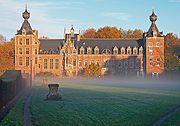
Arenberg Castle
Encyclopedia

Heverlee
Heverlee is a town in Belgium. It is a deelgemeente of the city of Leuven. Heverlee is bordered by Herent, Bertem, Oud Heverlee and several other municipalities that are part of Leuven ....
close to Leuven
Leuven
Leuven is the capital of the province of Flemish Brabant in the Flemish Region, Belgium...
in Belgium
Belgium
Belgium , officially the Kingdom of Belgium, is a federal state in Western Europe. It is a founding member of the European Union and hosts the EU's headquarters, and those of several other major international organisations such as NATO.Belgium is also a member of, or affiliated to, many...
. It is surrounded by a park.
History
The site had been the castle of the lords of Heverlee since the 12th century, but this family became impoverished and had to sell the site in 1445 to the Croÿ family from PicardyPicardy
This article is about the historical French province. For other uses, see Picardy .Picardy is a historical province of France, in the north of France...
. Antoon van Croy demolished the medieval castle and started works to build the current castle in 1455 on the site, of which he destroyed all but one tower. Willem van Croÿ completed the works on the castle in 1515, and founded a monastery on the castle grounds for the Benedictine
Benedictine
Benedictine refers to the spirituality and consecrated life in accordance with the Rule of St Benedict, written by Benedict of Nursia in the sixth century for the cenobitic communities he founded in central Italy. The most notable of these is Monte Cassino, the first monastery founded by Benedict...
Celestines
Celestines
Celestines are a Roman Catholic monastic order, a branch of the Benedictines, founded in 1244. At the foundation of the new rule, they were called Hermits of St Damiano, or Moronites , and did not assume the appellation of Celestines until after the election of their founder to the Papacy as...
. The architectural style is in large part traditionally Flemish, with sandstone window frames and brick walls, though it has been structurally altered since 1515 and has elements of Gothic
Gothic architecture
Gothic architecture is a style of architecture that flourished during the high and late medieval period. It evolved from Romanesque architecture and was succeeded by Renaissance architecture....
, Renaissance
Renaissance architecture
Renaissance architecture is the architecture of the period between the early 15th and early 17th centuries in different regions of Europe, demonstrating a conscious revival and development of certain elements of ancient Greek and Roman thought and material culture. Stylistically, Renaissance...
and Neo Gothic architecture. Its large corner towers are typical, once surmounted by a German eagle.
Charles III of Croy
Charles III de Croÿ
Charles III de Croÿ was Seigneur de Croÿ, 4th Duke of Aarschot, 5th Prince of Chimay and 5th Count of Beaumont....
was the 4th and last duke, and after his death in 1612 without issue the castle passed to the Arenberg family into which his sister had married, and remained in that family until the First World War.
The first manned gas-filled balloon flight in history took off from the front lawn of the castle on November 21, 1783; the balloonist was professor Jan Pieter Minckeleers.
Even before the First World War, the 8th duke of Arenberg wanted to sell the castle and its grounds to the Catholic University of Leuven
Catholic University of Leuven
The Catholic University of Leuven, or of Louvain, was the largest, oldest and most prominent university in Belgium. The university was founded in 1425 as the University of Leuven by John IV, Duke of Brabant and approved by a Papal bull by Pope Martin V.During France's occupation of Belgium in the...
, for a reasonable price. During the First World War, the castle and grounds were occupied by the Germans and Austrians. The castle and park were seized by the Belgian government on the outbreak of, and then after the war since the Arenberg family was considered to be German or Austrian due to their close Habsburg connection, monarchs of Austria-Hungary. It took until 1921 for the University to acquire them, becoming an expanded natural sciences and engineering campus in the style of that of an American university. After the partitioning of the University along language lines in 1968, the castle and grounds remained with the Dutch speaking half as one of the main campuses for the new, independent Katholieke Universiteit Leuven
Katholieke Universiteit Leuven
The Katholieke Universiteit Leuven is a Dutch-speaking university in Flanders, Belgium.It is located at the centre of the historic town of Leuven, and is a prominent part of the city, home to the university since 1425...
. The castle itself is the main building of the Faculty of Engineering and houses lecture rooms and studios for the Department of Architecture, Urbanism and Urban Planning, including the Post-Graduate Centre Human Settlements and the Raymond Lemaire International Centre for Conservation. The building is open to the public. The former Celestine monastery on the castle grounds now houses the campus library, and the addresses of many of the science buildings are on the street named, Celestijnlaan.

